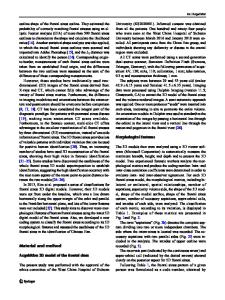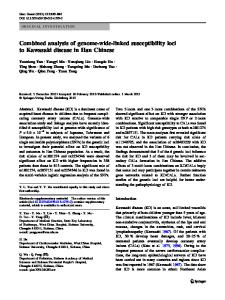Haplotype analysis of 36 Y-STR loci in a Chinese Han population from Anhui Province, Eastern China
- PDF / 164,348 Bytes
- 3 Pages / 595.276 x 790.866 pts Page_size
- 89 Downloads / 442 Views
POPULATION DATA
Haplotype analysis of 36 Y-STR loci in a Chinese Han population from Anhui Province, Eastern China Chi-Zao Wang 1,2,3 & Jia-Shuo Zhang 4 & Xue-Bo Li 4 & Ru-Feng Bai 5 & Mei-Sen Shi 5 & Chuan-Chao Wang 6 Received: 13 February 2020 / Accepted: 20 May 2020 # Springer-Verlag GmbH Germany, part of Springer Nature 2020
Abstract We analyzed haplotypes for 36 Y chromosomal STRs (Y-STRs), including 27 Yfiler Plus loci and 9 additional STRs (DYS549, DYS643, DYS508, DYS447, DYS596, DYS444, DYS557, and DYS527a/b) in 2018 unrelated Chinese Han individuals from Anhui Province using DNATyperTM 36Y Kit. Phylogenetic analysis was performed to determine the genetic relationship of the Anhui Han population with other neighboring and/or linguistically close populations. Keywords Y-STRs . Haplotype . Phylogenetic analysis . Anhui Han
Introduction Y chromosomal–specific short tandem repeat (Y-STR) markers are inherited paternally, and their haplotype distribution may be distinct from other populations of different geographic regions or different ethnic backgrounds. A new 6-dye DNATyperTM 36Y Kit (no. 2 Institute of the Ministry of Public Security, Beijing, China) including 27 Yfiler Plus loci, 9 additional STRs (DYS549, DYS643, DYS508, DYS447, DYS596, DYS444, DYS557, and DYS527a/b), and three YIndels was produced in light of the continuous demand for developing more efficient and discriminative Y-STR haplotyping systems in China. To take full advantage of the increased resolution of the Y chromosome haplotype analysis
offered by DNATyperTM 36Y Kit, it is necessary to collect haplotype frequency data for as many population samples as possible. Anhui Province is situated in Eastern China, extending across Changjiang (Yangtze) River and Huaihe River valleys. Rich water resources provided favorable conditions for the development of many prosperous ancient cultures. Archaeological discoveries indicated that there were many prehistoric remains of human activities [1, 2], but the population loss was usually large due to frequent wars during historical periods [3]. Nowadays, the population of Anhui is mainly composed of descendants of Han immigrants from other adjacent provinces in Eastern China since the Ming Dynasty (A.D. 1368–A.D. 1644) [4] and Han Chinese make up the vast majority of its population (99.34%, about 60 million).
Chi-Zao Wang and Jia-Shuo Zhang contributed equally to this work. Electronic supplementary material The online version of this article (https://doi.org/10.1007/s00414-020-02321-0) contains supplementary material, which is available to authorized users. * Mei-Sen Shi [email protected]
4
Key Laboratory of Evidence Identification in Universities of Shandong Province, Shandong University of Political Science and Law, Jinan 250014, People’s Republic of China
5
Criminal Justice College of China University of Political Science and Law, Beijing 100088, People’s Republic of China
6
Department of Anthropology and Ethnology, Institute of Anthropology, National Institute for Data Science in Health an
Data Loading...











